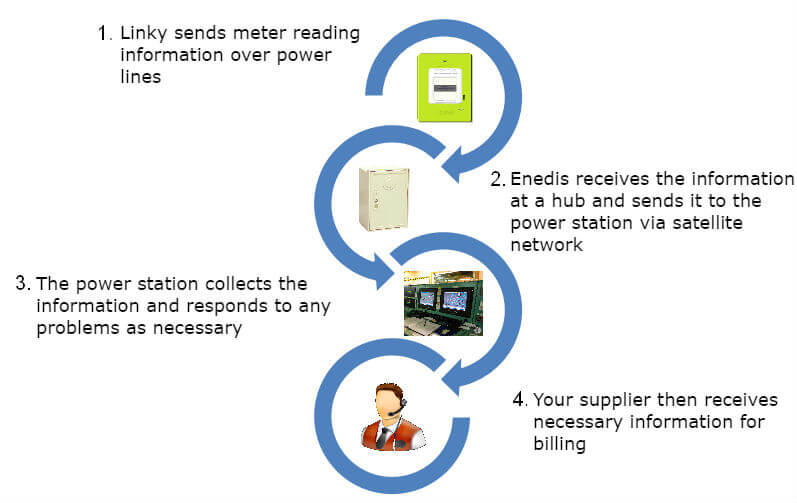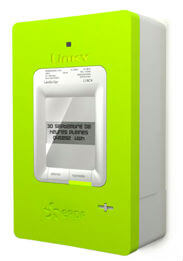Linky: the Smart Meter for electricity in France

Linky meters are smart meters, currently being deployed nationwide in France by French power grid operator Enedis. Find out everything you need to know about the Linky meter in France in our guide.
How the Linky Smart Meter Works

Unlike traditional mechanical (analogue) meters, which simply measure electricity as it is consumed, the Linky meter contains a small communication chip and battery that allows it to be in regular communication with Enedis, the power grid operator. The communication chip sends meter reading data to Enedis' system twice a day (it rests dormant between these times). This meter reading information is sent via Broadband over Power Line (BPL), a high-frequency radio signal that is sent along power lines.
Advantages of the Linky
- No need to report meter readings, or to allow a technician come into your home to read your meter
- You can benefit from actual consumption offers, rather than on an estimation
- More accurate information about your energy consumption may help you adopt energy-saving measures
- Changing the meter power capacity and changing a single phase meter to triple phase can be done remotely and does not require an Enedis technician appointment
- Linky meters also facilitate household renewable energy installations, as they can record both energy consumed and energy produced
The switch to the Linky meter will also allow you to switch to time of use pricing (in French, this is known as the heures creuses-heures pleines). Households with a Linky will also be able to access their consumption information online.
Does a Smart Meter Impose Health Risks?
Smart meters have met resistance in many communities throughout the world due to concerns over the health effects of radiation that smart meters emit. However, this type of radiation is low-energy radiation, which means it has enough energy to move atoms in a molecule around or cause them to vibrate and can lead to heat, but not enough energy to damage DNA directly. While RF radiation is classified as "possibly carcinogenic to humans" (according to the World Health Organisation), emissions from smart meters are very small - less than the emissions from a microwave oven. Further, as electricity meters are typically installed outside the home, they are further away than other possible sources of RF radiation (such as cell phones or cordless phones), and are to some extent blocked by the walls of the home as well. Finally, smart meters typically send and receive short messages about 1% of the time that they are running. This means that the amount of RF exposure from Linky smart meters is probably a lot lower than possible exposure from other sources.
Who is Responsible for Installing Linky Meters?

Enedis (ex ERDF), the power grid operator for most of France, is responsible for installing the new Linky meters. After an initial pilot phase that took place in 2010 (in which over 250 000 Linky meters were deployed in Lyon and the Indre-et-Loire regions), a national deployment campaign began in December 2015. Over 28 million Linky meters will be installed in the programme, which is scheduled to finish in 2021.
The pilot phase demonstrated that Linky smart meter adoption can lead to reduced management errors and frauds, better peak supply management, and fewer billing complaints. The programme is part of a wider initiative to adopt smart meters across Europe, and France has committed to 95% smart meter penetration by 2020. Each country participating in the EU smart meter rollout plan has been able to choose its own infrastructure model, and France has chosen the Linky smart meter.
Customers who have not yet had a Linky meter installed in their home can find the date of their scheduled installation on this page. They will receive a letter 30 - 45 days before the planned installation date, along with a suggested appointment time, if the inhabitant is required to be present. The installation process takes approximately 30 minutes in total, during which the power will be cut for approximately 15 minutes. Linky installation technicians will wear photo identification that contains a "Partenaire Linky par Enedis"
How Much Does the Linky Cost?
The entire Linky rollout programme is projected to cost approximately 5 billion Euros over six years, between the costs of procurement, installation, and the development of a new IT system. An individual Linky meter costs an estimated 150€ to 200€ to install, and while obligatory for French households, it comes at no cost to the consumer. While a fairly considerable upfront investment for Enedis, Linky meter installations are expected to lead to savings of approximately 24€ to 30€ per household per year (as technicians will no longer need to be deployed to make manual meter readings).
Note that it is not permitted to refuse the installation of a Linky meter (find out more - in French).
Did you know? The smart gas meter (Gazpar) deployment program has been achieved in 2022, before having commenced in 2017.

How to Read a Linky Meter?
The Linky meters are designed for easy replacement, and are the same size as conventional meters. You will find the meter number written on the white part of the meter that contains the digital meter screen. Directly above it is a flashing light that indicates the rate at which electricity is being consumed (the greater the consumption, the quicker the light flashes). The screen indicates information such as electricity consumption, your electricity tariff/price option, and your meter's power capacity.
